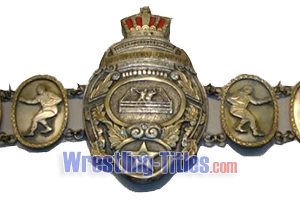
Professional wrestling championships often have uncertain origins. That’s why the lineage is more important than the origin. The value of a championship can be elevated not by how it was introduced, but by the qualities of the champions and their title defense matches.
After World War II, Rikidōzan established professional wrestling in Japan, and one of the most prestigious championships managed by Japanese organizations is the International Heavyweight Championship, which is currently one of three titles of which All Japan Pro Wrestling‘s Triple Crown Heavyweight Championship consists.
On 1957-11-14, in Toronto, Ontario, Lou Thesz lost the NWA World Heavyweight Championship to Dick Hutton. Afterwards, Thesz went on a European tour and, recognizing his long-standing accomplishments as a world champion, felt the need for some sort of championship, so he proclaimed himself the “International” champion. Although it was not officially recognized by the NWA, Thesz later wrote to an American wrestling publication that he had obtained permission from the NWA. While he often wrestled as the world champion during his UK tour, it seems that he was billed as the International champion in France.
In Houston, Texas, the local promoter Morris Sigel apparently announced that Thesz won the title “from Antonino Rocca in 1949,” but there is no record of any match in Texas or New York where Rocca held the title.
Thesz stayed in Europe until 1958-02. After returning to the U.S. in March, he continued to defend the International Championship in California, Utah, Idaho, and Texas.
Then, on 1958-08-27, he was defeated by Rikidōzan in Los Angeles.
At that time, there were various rumors and suspicions, such as “Rikidōzan captured the world title,” “In reality, Thesz had already lost the world title, and what Rikidōzan took was the International Championship,” and “He captured the title, but there was no belt.” However, the match itself was a non-title match, meaning no championship was at stake.
The following excerpts are from the U.S. military newspaper Pacific Stars And Stripes, with articles from Associated Press on the left from August 29 and United Press International on the right from September 3. The AP report clearly states that the title was not at stake, and furthermore, the UPI article mentions that Rikidōzan is confusing Japanese fans.

According to The Los Angeles Times, Thesz is introduced as the International champion in the article on the day of the match. However, there is no mention of whether it was a championship match in the card results on the following day.
After this match, Thesz continued to claim the title in various locations. This can be confirmed from an article in Missouri in 1963-01, and about two weeks later, he regained the world title by defeating Buddy Rogers. In other words, Thesz spent most of the period when he was not the world champion performing as the International champion. I complied a list of Thesz’s International title defenses during that period. There are likely more defenses than those listed here.
During the territorial days of professional wrestling in the United States and Canada, it has been a recurring practice to bill wrestlers coming in from other territories as some sort of champions, and then have local wrestlers defeat them, creating the illusion of capturing titles from other regions. They would often report fictional title wins using names of locations outside the state or overseas. The creation of the International Championship in Japan had a somewhat similar situation.
It is, however, a fact that the International Heavyweight Championship became regarded as a “treasure” in the Japanese pro-wrestling history. Like many other championships, it is more important to focus on how it built its history rather than how it began.
Nevertheless, as a title history enthusiast, I couldn’t resist mentioning these details.
Translated from Puroresu Blog



